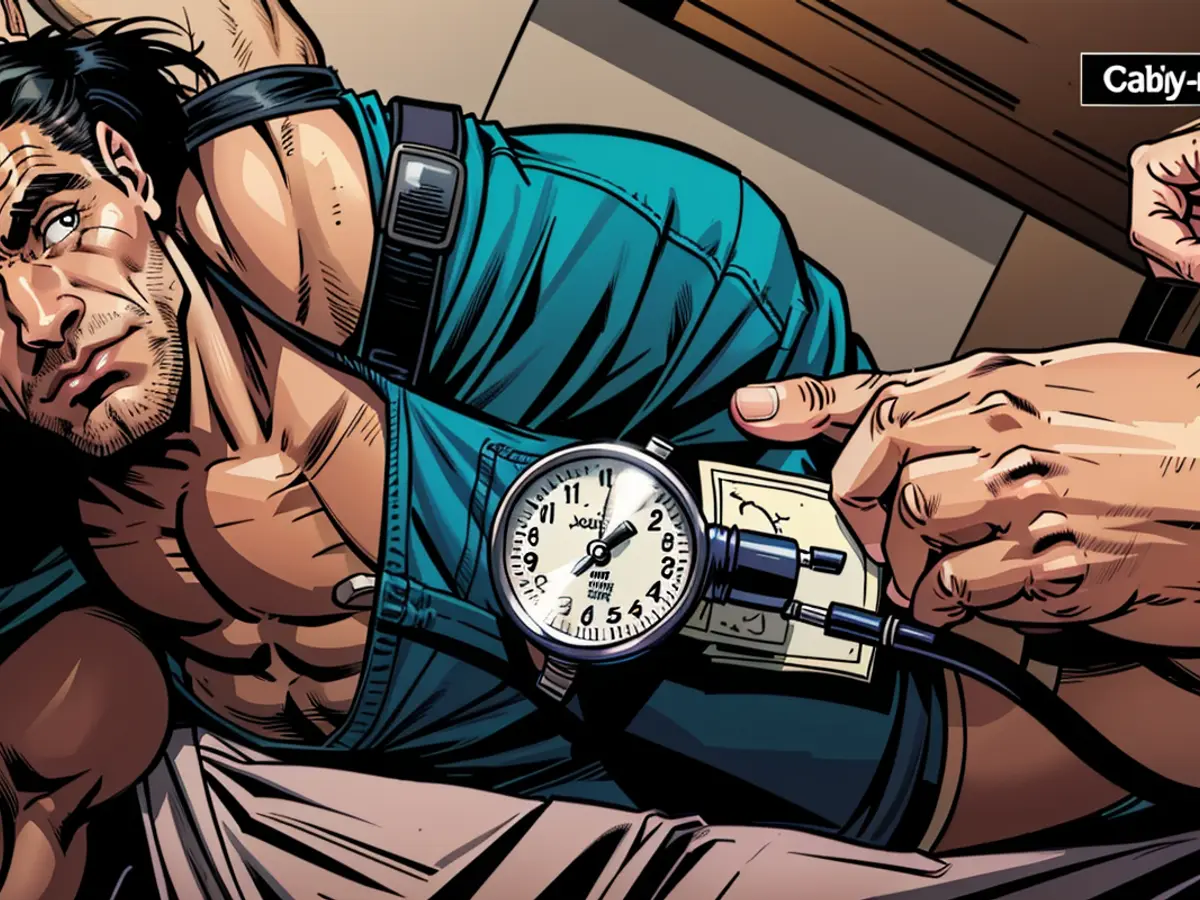In some instances, specific poses often utilized during blood pressure assessments might result in faulty readings. Learn the correct method here.
It's been suggested that inconsistently positioning and supporting your arm appropriately during a blood pressure test might lead to an incorrect diagnosis of high blood pressure, which some professionals worry could potentially result in unnecessary treatment.
A study published in the journal JAMA Internal Medicine on Monday discovered that resting your arm on your lap during a blood pressure test can result in an enhanced systolic blood pressure measurement by 3.9 mm Hg and an enhanced diastolic reading by 4 mm Hg. Placing your arm by your side can cause an enhanced systolic reading by 6.5 mm Hg and an enhanced diastolic reading by 4.4 mm Hg.
Blood pressure is measured in mm Hg (millimeters of mercury), which consists of two numbers - the upper or systolic reading and the lower or diastolic reading. A person is considered to have high blood pressure or hypertension if they have consistent readings of 130/80 or higher.
Dr. Tammy Brady, the study's senior author and vice chair for clinical research in the department of pediatrics at the Johns Hopkins University School of Medicine, stated, "Healthcare providers need to be reminded about the importance of taking the time to follow these steps properly." Her hope is that the study raises awareness of how important factors like arm position are to blood pressure measurement accuracy.
Brady also hopes the research will educate patients, empowering them to advocate for accurate measurements in a clinic setting. She added, "Because so many patients rely on home blood pressure measurements for hypertension diagnosis, evaluation, and treatment, I hope this study also educates them on how to properly position their arms at home, as our findings also apply to home measurements."
The study was conducted by researchers from Johns Hopkins University, who recruited 133 adults from Baltimore, Maryland, between August 2022 and June 2023. The participants, aged 18 to 80, were randomly assigned to have their blood pressure measured with their arms in three different positions - supported on a desk, as is the recommended standard practice; supported on their lap; or hanging by their side, unsupported.
Each participant underwent a total of 12 blood pressure measurements with their arms in each of the various positions. When the participants' arms were supported on a desk as per standard clinical guidelines, the average of their blood pressure reading was 126/74, the researchers found. However, when the participants' arms were resting in their laps during readings, the average blood pressure reading was 130/78, and when their arms were hanging by their sides, the average of their readings was 133/78.
Brady was surprised by the significant difference in blood pressure readings when the arms were placed in alternative positions, stating, "We did not expect there to be such a difference when the arms were placed in these two alternative positions. We tested those positions because those are the positions that most people have their blood pressure measured, according to data and personal observations."
There are several physiological reasons why blood pressure measurements could be overestimated when the arm is not adequately positioned or supported. A greater vertical distance between the heart and where the cuff is placed can increase hydrostatic pressure in the arteries due to gravity's pull, leading to an overestimation of blood pressure. An unsupported arm can also cause muscle contraction, which may result in an increase in blood pressure.
Properly measuring blood pressure
The new study findings are consistent with previous research that has shown unsupported arm positions or the arm being positioned below heart level can overestimate a blood pressure reading.
Dr. Nichola Davis, vice president and chief population health officer at NYC Health and Hospitals, who was not involved in the study, commented, "This study gives us a more precise measure of just how much this has an impact."
According to the latest clinical practice guidelines, several key steps should be followed for accurate blood pressure measurement, including:
- Wearing the appropriate cuff size.
- Having your back supported.
- Keeping your feet flat on the floor with your legs uncrossed.
- Positioning the cuff at heart level with the arm supported on a desk or table.
Using an improperly sized blood pressure cuff can distort readings taken by automated blood pressure devices, as a study published last year in the journal JAMA Internal Medicine found. Researchers found that using standard, regular-sized blood pressure cuffs resulted in "strikingly inaccurate" readings for participants who required differently sized cuffs, particularly for those who fit larger cuffs.
There are some steps people should take before getting their blood pressure checked, said Dr. Gail Adler, a cardiovascular endocrinologist and co-specialist in the Hypertension Clinic at Brigham and Women's Hospital, who was not involved in the new study.
"In the 30 minutes before you take your blood pressure, you want no smoking, no exercise, no caffeine, no alcohol, and... no major arguments. Don't be psychologically stressed," Adler said.
Firstly, you should find a comfortable chair, adjust your position appropriately, and relax for five minutes without talking. Keep your arm at ease, maintain an upright posture with a straight back, and ensure your legs aren't crossed, with both feet flat on the floor. It's essential to avoid the need to urinate during this process to prevent a surge in your blood pressure. When taking your blood pressure, the cuff should be placed directly on your arm, not over any clothing.
Home environment often leads to more relaxed and natural blood pressure readings, as studies suggest that home blood pressure readings serve as a better gauge of your regular blood pressure level compared to office readings.
In clinical practice, blood pressure measurements are frequently performed improperly, resulting in misleading information that has the potential to impact medical decisions regarding blood pressure management in approximately 20% to 45% of patients, according to the American Medical Association.
Attention to accurate blood pressure measurements has become more important for the study team members, including myself, when it comes to ensuring proper measurement for our own blood pressure as well as for our family members.
'Let's avoid rash conclusions'
Hypertension increases the risk for heart ailments and stroke, which are leading causes of death in the United States.
Approximately half of American adults suffer from hypertension, but less than 25% of those individuals have their blood pressure under control, according to the US Centers for Disease Control and Prevention.
In the U.S., the treatment of hypertension is not aggressive enough, in the opinion of Dr. Dave Montgomery, a cardiologist from Piedmont Healthcare in Atlanta who was not involved in the new study.
"Hypertension is one of the most common risk factors for cardiovascular disease and is relatively easy to diagnose and manage. Regrettably, hypertension often goes overlooked, contributing significantly to cardiovascular morbidity and mortality," Montgomery said.
Regarding the new study, he does not believe that an error in blood pressure reading of 4 to 5 mm Hg due to arm position would lead to misdiagnosis or excessive treatment, such as a prescription change or dosage adjustment.
"If someone has normal blood pressure, a 4 mmHg discrepancy won't have any impact. However, in someone diagnosed with hypertension, a difference of 5 to 10 points may indicate that we have not achieved the desired control," Montgomery explained. He emphasized that blood pressure can fluctuate significantly within minutes, influenced by physical factors and an individual's emotional state.
"Overall, we should avoid jumping to conclusions based on a single blood pressure reading. Persistently high blood pressure requires aggressive treatment to reduce the burden of heart disease," he concluded.
The importance of properly positioning and supporting your arm during a blood pressure test is highlighted in a study, as incorrect arm positioning can lead to inflated readings and potentially unnecessary treatment. Maintaining good health involves regular blood pressure monitoring, both at home and clinically, and understanding the importance of proper arm positioning can help ensure accurate readings.








